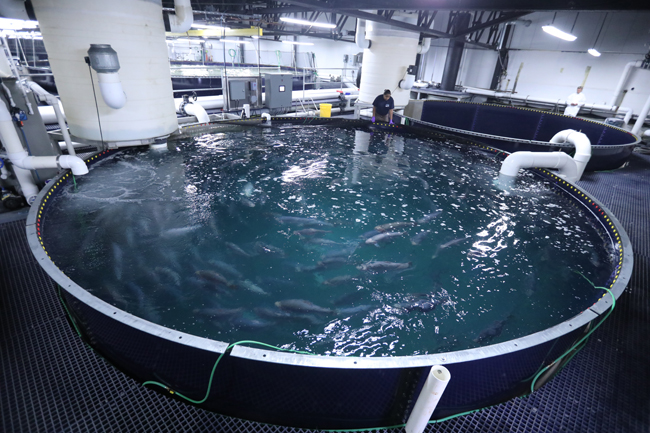
Commercial scale recirculating system culturing steelhead trout. Credit: John Ng/Hudson Valley Fisheries
Contact:
Barry Udelson, NYSG Aquaculture Specialist, E: bu25@cornell.edu, P: (631) 632-8730
— Content compiled by Emma Forbes; Revised by Barry Udelson
Stony Brook, NY, September 5, 2023 - Aquaculture is the cultivation of finfish, aquatic plants, and shellfish. It can be done on land using freshwater, in tanks and ponds, or in the marine habitat in saltwater.
When done properly, it is an environmentally responsible and sustainable way to produce seafood. Locally grown seafood can limit food insecurities and reduce the carbon footprint associated with imported seafood. It also contributes to the rebuilding of wild stocks and can lead to healthier ecosystems.
Global and National Aquaculture Facts
• Globally, aquaculture provides more than 50% of the seafood for human consumption. Due to wild harvest levels having plateaued since the 1990’s, aquaculture production has increased and surpassed wild caught seafood levels.1
• The U.S. currently imports 75% of its seafood, resulting in a $17 billion seafood trade deficit. More than half the imported seafood is raised via aquaculture.1,2
• In 2020, the U.S. ranked 18th in aquaculture production at 658 million pounds, with a value of $1.5 billion.2
New York Aquaculture Facts
• Historically, New York was an aquaculture pioneer, with shellfish activities beginning in the early 1820’s and the first fish hatchery created in 1864.3
• Aquaculture operations stretch from the Great Lakes region to Long Island, supporting about 38 finfish farms and over 50 shellfish farmers as of 2023.
• New York’s aquaculture industry generated $8.8 million in 2018 ($7 million from the shellfish sector).4
• Despite having the 3rd longest coastline and 5th largest land area among the Great Lakes and Northeast States, NY ranks 19th in the country for aquaculture production, behind smaller states.4,5,6
• The aquaculture industry in NY has significant room to grow!
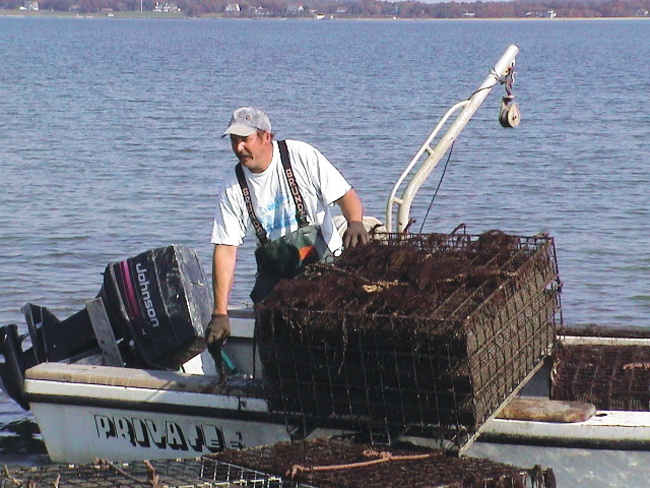
Oyster farmer using a davit and pulley system to lift shellfish cages. Credit: Gregg Rivara/CCE Suffolk County

(At left) Cultured oyster seed, about 10mm in size; (At right) Cultured hard clam seed, about 33mm in size. Credit: Barry Udelson/NYSG
What is Aquaculture Used for In New York?
Source of Food
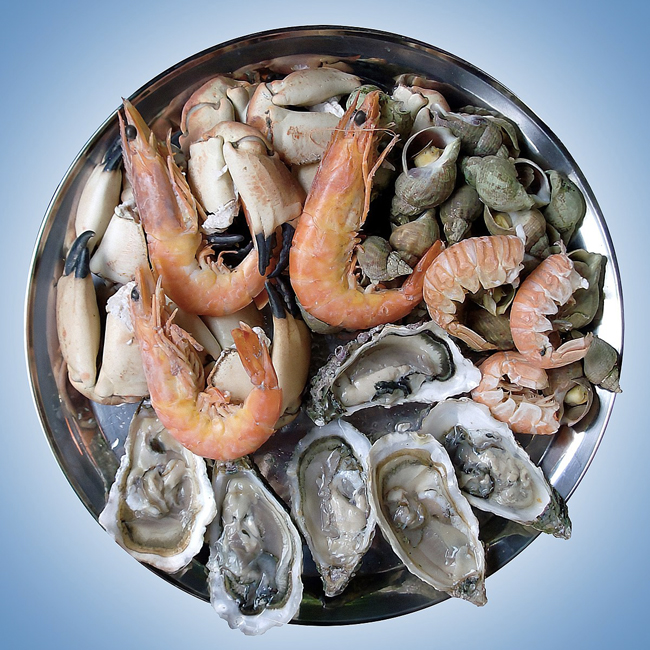
Fun Fact: Does the term seafood include both freshwater and marine species? YES! The term seafood refers to edible aquatic animals — both freshwater and marine.
New York has both small-scale and commercial- scale aquaculture operations that grow fresh, safe, and sustainable seafood year round. Oyster is the dominant shellfish species raised but some also raise hard clam and bay scallops. Various freshwater fish including trout, salmon, bass and tilapia are being raised. Aquatic plants such as sugar kelp have also become a crop farmers are starting to raise.
The cultivation of these species is ideal because they provide a great source of sustainably produced protein for our growing population. Fish convert feed into protein for human consumption more efficiently than beef, pork, and poultry. Shellfish and aquatic plants get all their nutrients for growth straight from the marine water body where they are grown and improve water quality at the same time.
Aquaponics is the practice of raising plants using nutrient rich water recirculated from tanks growing fish. This results in a very efficient system and is becoming more common in New York.
Stocking and Restoration
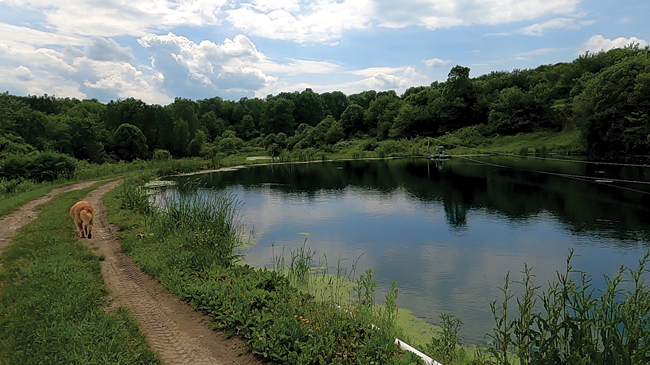
Upstate fish pond used for summer grow-out of largemouth bass. Credit: Emma Forbes/NYSG
New York has an extensive fish stocking program with 17 state operated hatcheries raising fish that are stocked into public waterways to support the recreational fishing industry and restore native populations.
Stocking is used to enhance recreational fishing and restore native species to their natural habitats. Landowners may also stock their private ponds to fish or to maintain a healthy pond ecosystem. Numerous locations stock ponds with cultured fish and charge visitors to come fish at their location. This is known as fee-fishing. As of 2023, there are 12 private hatcheries raising fish for stocking purposes or for baitfish.
Shellfish restoration is common on Long Island with numerous municipal shellfish hatcheries planting oyster, clam, and bay scallop seed into the bays to improve water quality and for residents to harvest.
How is Land-Based Aquaculture Done in New York?
Freshwater Finfish Aquaculture Background
Adult fish (known as broodstock) are spawned and their eggs are maintained until they hatch. These baby fish are known as “fry”, and raised until they reach a few inches in length and are known as fingerlings. This is typically done at a hatchery before being distributed to farms at the fingerling size. In New York, some hatcheries spawn adults and raise the fish through all its stages but many farms import eggs, fry, or fingerlings depending on their farm’s capabilities. They can be imported from hatcheries in New York or other states. It is common for farms that raise fish for stocking purposes to import fingerlings rather than undergoing the hatchery process.
Farms in New York raise a variety of freshwater fish for either consumption or for stocking purposes. This includes numerous species such as trout, salmon, tilapia, largemouth bass and many smaller species of baitfish for the recreational fishing industry.
Pond System

Ponds for aquaculture are man-made and are typically shallow and drainable, allowing easy harvest of crops. These types of grow-out systems are seasonal in New York, usually stocking the pond for grow-out in early April and harvesting the last of the crop in late October/early November.
Raceway System
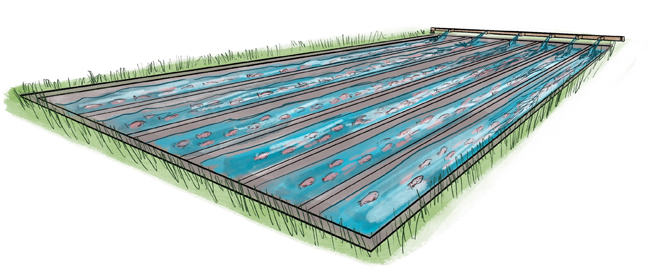
Raceways or flow through systems are rectangular channels that have a steady flow of water being pushed through from springs, wells, or streams. The first hatcheries in New York used flow through systems and many state hatcheries still do. Often this method is used till the fish reach proper stocking size and then the fish are released into lakes and rivers.
Recirculating Aquaculture Systems (RAS)
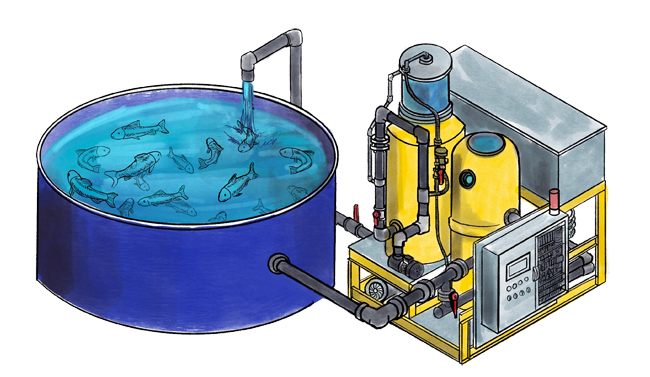
RAS technology uses tanks with a water supply that is filtered and reused. Numerous tanks can be incorporated into this type of system which is very efficient, recycling 90-95% of the water. This technology is becoming more prevalent due to its low impact on the environment and natural resources. Currently, New York has both small and commercial-scale RAS facilities that are only raising finfish but shrimp could also be raised. This technology can also be used to raise numerous plants with minimal modifications to become an aquaponic system.
Aquaponic System
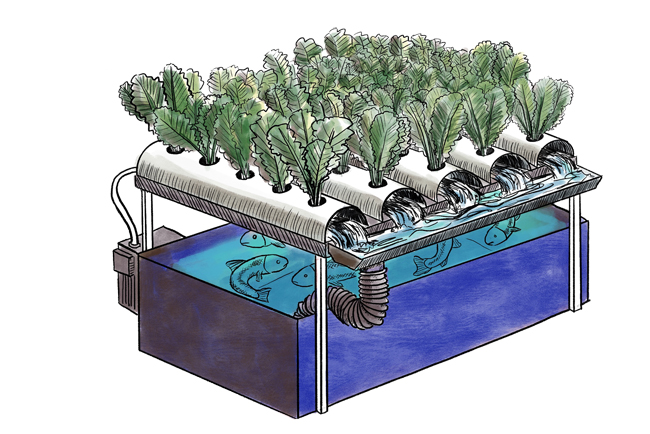
Aquaponics is the combination of aquaculture and hydroponic systems. By utilizing RAS technology (see above), plants are raised using the recirculating water from the tanks containing fish (or shrimp). The plants absorb the ammonia and nitrogen from the water which reduces effort needed to maintain water quality. This diversifies and increases the production of the farm. These systems can be designed to be large or small scale and set up virtually anywhere. There are currently a few aquaponic farms in New York, but there is an expanding interest for many who want to provide fresh vegetables, fish, and other products to their local communities.
How is Marine Aquaculture Done in New York?
Marine Aquaculture Background
Marine aquaculture is the cultivation of finfish, shellfish, aquatic plants (i.e., macroalgae or seaweed) , or crustaceans (e.g., shrimp) grown in the saltwater, marine environment. Currently in New York, only shellfish and macroalgae are being raised although a business is in the process of trying to acquire permits for an off-shore fish farm. Shellfish aquaculture includes the raising of oyster, clam, mussels, and scallops. Shellfish are generally raised for food or habitat restoration. Aquatic plant or macroalgae production is still developing in New York and mostly involves the cultivation of sugar kelp. Other native species could also be raised and are currently being researched for implementation. Aquatic plants can be raised for a variety of purposes including consumption, as bio-plastics, the cosmetic industry, as an animal feed, and as a bio-stimulant in fertilizer.
Shellfish Aquaculture
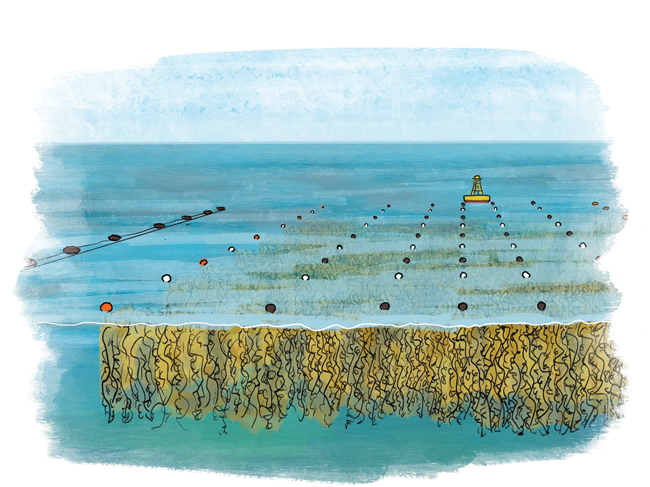
Prior to raising the shellfish on the farm, the juvenile shellfish or “seed” must be acquired from a hatchery where the shellfish is cultured. There are several hatcheries in New York that produce seed but many farmers still need to import it from other states due to the limited supply of it. Farmers are able to lease designated areas in bays to grow their crop and they choose a grow-out method that best suits their farm’s location, taking into consideration tides, wind, and wave action. There are two general methods, either raising shellfish on or off the bottom. On-bottom is when shellfish are planted directly on the bay bottom and harvested by raking or dredging them up to harvest. This is not commonly done in New York anymore and most farmers use the off-bottom method.
Off-bottom culture can be done using a few different techniques, either in cages resting on the bottom, suspended in the water column, or floating. There are a variety of off-bottom culture systems, including cage, tray, or rack and bag. The type of grow-out method used depends on the farm’s location. This technique usually has faster growth rates and easier control of fouling on the shellfish and gear.
Aquatic Plant Aquaculture
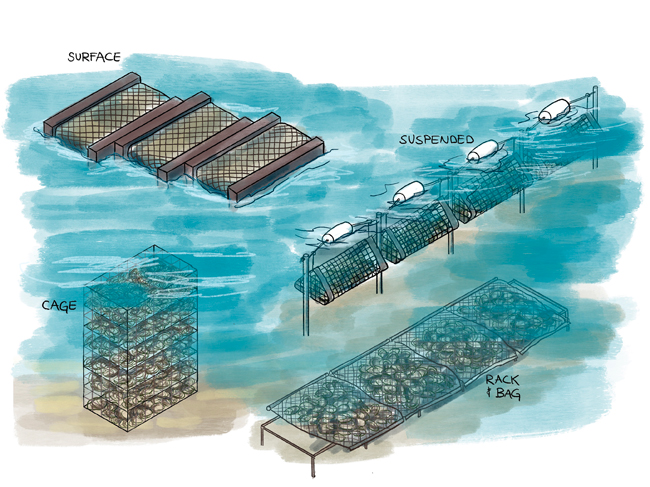
Aquatic plants, such as sugar kelp, are raised while being attached to strings that are suspended in the water column. The “seed” must be acquired from wild macroalgae and then set on the spools of string in a hatchery until they are ready to be deployed on the farm.
Sugar kelp grows during the winter months and can be raised on farms where oysters are also being grown. In just a few months, the sugar kelp is ready to be harvested which involves removal of the lines and processing the kelp. Various methods are used to process the kelp based upon it’s end use and can include drying, milling, freezing, or blanching.
References
1 FAO. (2022). The State of World Fisheries and Aquaculture 2022. Towards Blue Transformation. Rome, FAO.
2 NOAA National Marine Fisheries (2022). Fisheries of the United States, 2020. U.S. Department of Commerce, NOAA Current Fishery Statistics No. 2020.
3 Parker, N. C. (1989). History, status, and future of aquaculture in the United States. Rev. Aquat. Sci, 1, 97-109.
4 United States Department of Agriculture. (2019). 2018 Census of Aquaculture (Special Studies Part 2 ed., Vol. 3, Publication No. AC-17-SS-2).
5 NOAA Office for Coastal Management. (www.shoreline.noaa.gov)
6 U.S. Census Bureau (www.census.gov/quickfacts)
More Info: New York Sea Grant
New York Sea Grant (NYSG), a cooperative program of Cornell University
and the State University of New York (SUNY), is one of 34 university-based
programs under the National Oceanic and Atmospheric Administration’s
National Sea Grant College Program.
Since 1971, NYSG has represented a statewide network of integrated
research, education and extension services promoting coastal community
economic vitality, environmental sustainability and citizen awareness
and understanding about the State’s marine and Great Lakes resources.
Through NYSG’s efforts, the combined talents of university scientists
and extension specialists help develop and transfer science-based
information to many coastal user groups—businesses and industries,
federal, state and local government decision-makers and agency managers,
educators, the media and the interested public.
The program maintains Great Lakes offices at Cornell University, SUNY
Buffalo, SUNY Oswego and the Wayne County Cooperative Extension office
in Newark. In the State's marine waters, NYSG has offices at Stony Brook
University and with Cornell Cooperative Extension of Nassau County on Long Island, Brooklyn College and Cornell Cooperative
Extension in NYC and Kingston in the Hudson Valley.
For updates on Sea Grant activities: www.nyseagrant.org has RSS, Facebook, Twitter, Instagram, and YouTube links. NYSG offers a free e-list sign up via www.nyseagrant.org/nycoastlines for its flagship publication, NY Coastlines/Currents, which is published quarterly.